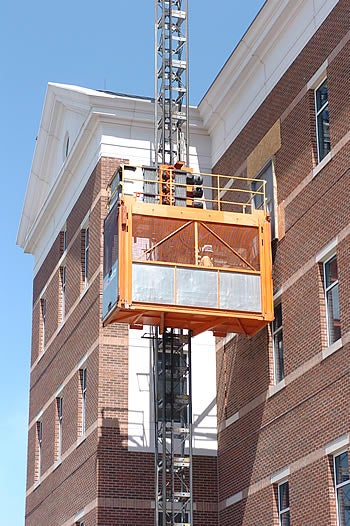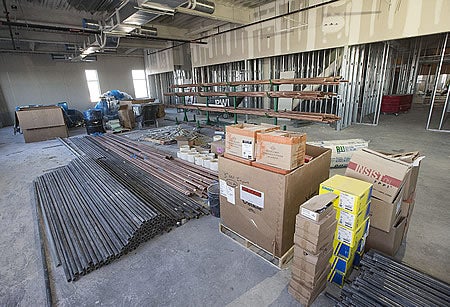ECHI fourth floor to soon be home to science, robotics
GREENVILLE, N.C. (Apr. 3, 2013) — By this time next year, scientists and clinicians will be working together to find clues to solving the region’s – and nation’s – diabetes epidemic in new lab space on the fourth floor of the East Carolina Heart Institute at East Carolina University.
Nearby, surgical teams from around the world will be learning the latest robotic surgery techniques.

Drs. Darrell Neufer and Wiley Nifong look over plans for the fourth floor of the East Carolina Heart Institute at ECU, which is being turned into research and training space. Photo by Cliff Hollis
That’s the goal of medical school officials, faculty members and contractors who are transforming the formerly unused space into advanced laboratories and simulated clinical rooms. The work is expected to be completed by this fall and the facility ready for use by the end of the year.
The research space isn’t meant to be a permanent home to any one department or researcher. Instead, the space is meant to be “fluid,” said Dr. Wiley Nifong, an associate professor of cardiovascular sciences and director of surgical robotics at the medical school.
Traditional office and lab spaces are combined with an open bench area on the south side of the floor, stretching nearly the length of the building. The design is meant to foster collaboration.
“A lot of corporate labs are like this,” Nifong said.
The robotic training area will mimic an actual operating room, with booms, lights and cameras, Nifong said. In addition to the DaVinci Surgical System by Intuitive Surgical, which ECU has used for a decade, training center officials are considering bringing in other robotic systems from other manufacturers, Nifong said.
“The scope of work and scope of practice are increasing,” said Nifong, who has trained more than 700 surgical teams on the DaVinci system at the ECU Robotic Research and Training Center.
When the $60 million, 206,000-square-foot ECHI at ECU opened in 2008 on the health sciences campus, the choice was to complete the fourth floor or the auditorium, said Dr. Darrell Neufer, professor of physiology and kinesiology, director of the East Carolina Diabetes and Obesity Institute and one of the faculty members leading the transformation of the fourth floor. ECU officials decided to complete the auditorium and related educational spaces and seek money for the fourth floor later.
Work on the 37,000-square-foot fourth floor is estimated to cost $11.5 million, Neufer said. Officials over the years have been plucking money from one source or another and earmarking it for the fourth floor project. A $1 million grant from the Golden LEAF Foundation bought equipment for the diabetes institute, some of which is in use and will be moved to the heart institute and some of which is still unopened and waiting in a warehouse to be moved to its new home, Neufer said.
Once the project is complete, Neufer will move his office from the sixth floor of the Brody Medical Sciences Building to the fourth floor of the heart institute. The Robotic Research and Training Center now in the Warren Life Sciences Building will move over. Some researchers from the Brody School of Medicine and the ECU College of Health and Human Performance who are studying metabolism-related fields will also move to the fourth floor. Altogether, anywhere from 80 to 120 people will work on the fourth floor, he added.
ECHI director Dr. W. Randolph Chitwood Jr. said the fourth floor project will benefit ECU and the region financially. “This is a real economic benefit for eastern North Carolina both for the (National Institutes of Health) funding and the money we bring in for the training center,” Chitwood said.
The Diabetes and Obesity Institute has approximately 50 affiliated faculty members from 18 ECU departments working in basic and clinical research, Neufer said. Last year, external grant funding for all affiliated faculty totaled more than $6 million. The new research space could help increase that figure.
“It’s no longer sufficient to be one investigator submitting your grant,” Neufer said. “Medicine has gotten so broad and diverse you need more people. The more diverse we are, the better because that fosters creativity. That’s the hope, to create an environment that is more collaborative.”
At the Robotic Research and Training Center, nearly 1,400 clinical personnel have trained in robotic cardiac, thoracic, gynecologic, urologic and general surgery. The center also devotes more than 500 hours each year to student programs and community groups, including internships with the Park Scholars program at N.C. State University and the ECU Honors College.
Once the center moves out of the Warren Building, basic science researchers from the medical school will move in, Nifong said.
- Workers use a temporary elevator to transport materials and themselves to the fourth floor. Photo by Doug Boyd
- Construction materials are seen on the fourth floor of the ECHI. Photo by Cliff Hollis

